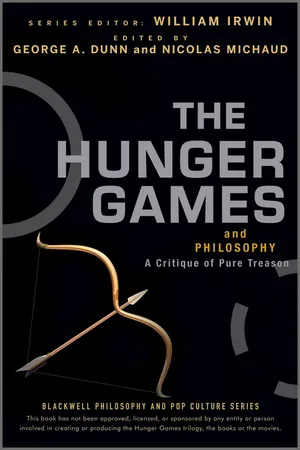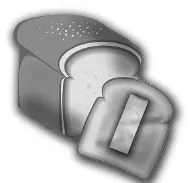![]()
PART ONE
“HAVING AN EYE FOR BEAUTY ISN’T NECESSARILY A WEAKNESS”: THE ART OF RESISTING THE CAPITOL
![]()
“THE FINAL WORD ON ENTERTAINMENT”
Mimetic and Monstrous Art in the Hunger Games
Brian McDonald
During what Katniss Everdeen calls “the worst [hours] of my life,” she is overwhelmed by the dying screams and whimpering moans of Cato as he’s torn apart in an exquisitely slow-motion death by the muttations, grotesque mixtures of different animals who, in a final hellacious touch, wear the facial features of the tributes who were killed earlier in the contest. “Why don’t they just kill him?” she cries out to Peeta Mellark, who simply replies, “You know why.” And she does. “From the Gamemakers’ point of view this is the final word in entertainment.”1
This flippantly despairing sentence announces one of the key themes of Suzanne Collins’s trilogy, the Hunger Games. The trilogy is, among other things, a cautionary tale about the dark side of entertainment. In a popular culture that glibly celebrates “pushing the envelope,” Collins imagines what might happen to our “envelopes” if we kept pushing them without ceasing. What if the ethos of Survivor and American Idol were taken to its logical extreme? What if our obsession with tattoos and “extreme sports” kept burgeoning? What if entertainment became the whole point of life, and the appetite for excitement swept away all of the limits formerly enforced by our battered moral sensibilities?
It’s unlikely that the lust for entertainment Collins satirizes will ever arrive at the “final word” of terror and torture she so effectively dramatizes. Rather, she’s engaging in the kind of exaggeration typical of dystopias: fictional works that take a negative cultural trend and imagine a future or an alternative world in which that trend dominates every aspect of life. But this very quality of exaggeration can be an aid to philosophical reflection. Just as an adept impersonator can throw a politician’s or celebrity’s features and mannerisms into sharp relief through artfully exaggerated caricature, dystopic fiction can give us a clearer view of certain aspects of the human condition by exaggerating them and dramatizing their possible distortions. In particular, the exaggerations of the Hunger Games highlight the place of the imaginative faculty that enables human beings to produce various forms of art, if we may use that word somewhat broadly (as befits a chapter in a book on philosophy and popular culture) to cover popular entertainment as well as so-called high art.
Philosophers, ancient and modern, have had a lot to say about art and its relation to human life and culture. By showing us a world where art, in however debased a form, has become the chief means of social and political control, the Hunger Games also helps us to reflect on its place in human life. We see its frightening power for both defacing our humanity in the hands of the Capitol and enhancing it in the hands of an artist-hero like Peeta.
“The Right Shade for Sunlight on Fur”
For most of our history, human beings have believed that true art not only entertains but also improves those who contemplate it. Most classical descriptions of the purpose of art include some variations on the phrase “to delight and instruct,” with the term instruct carrying clear moral implications. What makes the dramatic pageantry of the arena such a horrifying “final word in entertainment,” however, is that its grotesque “delights” are wholly divorced from any kind of “instruction.” According to the Greek philosopher Aristotle (384–322 BCE), productions that entertain without elevating the soul are mere “spectacle,” and although spectacle is one element in the dramatic arts, he thought it was the lowest, least important, and most dispensable element.2
Aristotle’s book on drama, the Poetics, is a good place to begin reflecting on the theme of art and entertainment in the Hunger Games, because his view of art as imitation, or mimesis, holds the key to understanding the difference between two uses of art in Panem: the horrific, though beautifully designed, spectacle of the Capitol and the “natural” art created by Peeta. For Aristotle, all of the arts—visual, performing, literary, and dramatic—are forms of mimesis.3 Whether it’s a play or a painting, an epic or a statue, art is always imagination’s attempt to represent something in a fictional form that exists in the real world. Art, according to Aristotle, is the highest testimony to the fact that human beings are “the most imitative of living creatures.” All of the arts flow from or appeal to that “instinct for imitation.”4 The appeal of artistic mimesis is so intense that “objects which in themselves we view with pain, we delight to contemplate when reproduced with minute fidelity, such as the forms of the most ignoble animals and of dead bodies.”5 To Aristotle’s list we might add the painful and grotesque events of the Hunger Games, which would be horrifying in real life but don’t spoil our “delight” in reading Collins’s novels.
Katniss first becomes aware of Peeta’s ability to reproduce natural objects with “minute fidelity” at the camouflage station while they are training for the 74th Hunger Games. “Peeta genuinely seems to enjoy this station,” she tells us.6 This should come as no surprise, given the love of mimesis that Aristotle believes is natural to human beings. Katniss and the trainer at the station marvel at Peeta’s talent for weaving artful designs from mud, clay, berry juices, vines, and leaves. Katniss is especially struck by a design that he has created on his arm: “The alternating patterns of light and dark suggest sunlight falling through leaves in the woods. I wonder how he knows this, since I doubt he’s ever been beyond the fence. Has he been able to pick this up from just that scraggly old apple tree in his backyard?”7
Peeta has been able to capture something that Katniss understands only due to her years of experience hunting and gathering in the woods. Could Peeta really have learned so much about the play of shadows from observing just one “scraggly old apple tree in his backyard”? Aristotle wouldn’t doubt for a moment that a talented artist like Peeta could accomplish that feat. Indeed, he believed that it was the function of artistic mimesis to disclose universal features of nature, such as the way sunlight in general appears as it falls through leaves, through the contemplation of particular phenomena, such as the sunlight that falls through the leaves of Peeta’s backyard apple tree.
Just how intense and powerful artistic mimesis can be is shown in a remarkable passage from the second book in the trilogy, Catching Fire, in which Peeta describes the “minute fidelity” of the artist in order to ease the dying moments of the morphling from District 6, who has intervened to save Katniss in the Quarter Quell and as a result has suffered a mortal wound. In baffled but awe-filled tones, Katniss reports Peeta’s words:
As Peeta’s words show, mimesis is not mere mimicry, a jabberjay’s mindless echoes of human sound. His mixing and reduplicating has involved him in a profound act of learning what color he’s trying to reproduce. Peeta’s words explain exactly why Aristotle associates the delights of artistic mimesis with the delight of learning.9 Peeta’s intense contemplation of a certain color is almost a form of communion with it, a learning so deep it comes from the inside out and not the outside in. After three days of mixing, he can reproduce the color because it has taken possession of his heart and his soul.
So powerful is the ecstasy of mimesis that Peeta is able to communicate it to the dying morphling, who is herself an artist. His artistic empathy causes him to see that beneath her bodily agony, beneath the layers of drug addiction and despair, at the deepest strata of her being is one who loves beauty and longs to reproduce it through artistic mimesis. He releases that deeply hidden being so that it may rise to the surface. The morphling’s death agonies seem to dissolve in peace as her final act is to trace with her fingers the outline of “what I think might be a flower” on Peeta’s cheek.10 Art has almost redeemed her death.
The elevating and procreative aspect of artistic mimesis provides the major redemptive note of the Hunger Games, but it couldn’t stand in starker contrast with the Capitol’s understanding and practice of art.
“We Could Really Make You Something Special”
If Peeta represents the regenerating power of artistic mimesis, the Capitol represents the monstrousness of art when it declares war on the principle of mimesis. Peeta’s intense and respectful devotion to the “natures of things” drives him to spend three days working to perfectly reproduce a color, but the artists and technicians of the Capitol approach the natural world as fodder to be set upon and remade into ever more grotesque and unnatural combinations. Unlike Peeta’s sunlight on white fur, “all the colors [in the Capitol] seem artificial, the pinks too deep, the greens too bright, the yellows painful to the eyes.”11 The insult to nature may seem relatively harmless when Capitol dwellers decorate their own bodies beyond recognition, but it takes a far more sinister form in the urge to desecrate and defile the bodies of others without restraint. The science that produces the muttations—and especially the grotesque human-animal hybrids—is a particularly horrific example of this defilement. Almost as sinister is the decorative preparation of the tributes’ bodies for their American Idol–like interviews prior to their dismemberment and destruction in the arena.
The perversions of Capitol art are displayed in its trivial details as well as in its horrific consequences, as we see in Katniss’s reaction to her prep team in Catching Fire:

